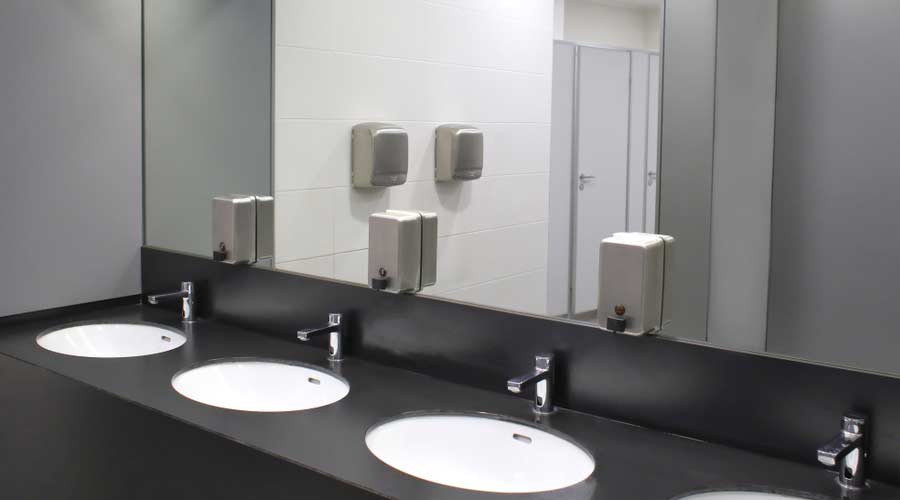How Restrooms Can Accommodate Post-Covid Expectations
When planning upgrades to restrooms and plumbing systems, managers have an ever-expanding range of options to consider.
By Thomas A. Westerkamp, contributing writer
Low-flow toilets, sinks and urinals combine low water flow rates with bowl designs that clear the fixtures more efficiently. Restrooms that incorporate sensor-operated fixtures, scheduled flushes, low-flow fixtures, effective housekeeping methods, and waterless urinals indicate to occupants that management has a forward-thinking approach to restroom design.
Toilet fixtures prior to 1992 used 3-5 gallons per flush (gpf), while newer fixtures require only 1.6 gpf. Newer sink faucets feature rates as low as 0.35 gallons per minute (gpm) using aerators. Urinals should have screens that fit in the urinal and eliminate splash. The screens attach to the urinal with suction cups, and they deodorize for 60 days, keeping the area smelling fresh. Floor splash pads for urinals absorb urine, prevent falls caused by wet floors, and minimize odors.
In restrooms that do not incorporate dispensers for feminine sanitary products, plumbers are kept busy unclogging toilets that restroom patrons use to dispose of these products. The result is wet floors, fall risks, unsanitary conditions, and health and safety issues. In addition to dispensers with a choice of products, managers can specify plastic or wax-coated bags that are available in dispensers of sanitary products. These bags, which allow sanitary disposal and prevent the spread of disease, must be available for the safety and health of occupants.
Matching needs and products
Among the ideas managers need to consider when upgrading restrooms and plumbing systems are no-touch low-flow fixtures, waterless urinals, under-sink tankless water heaters, paper towel dispensers, stainless steel vandal-proof partitions, and touchless door handles. When specifying stall partitions and doors, they also need to consider product materials, including coated steel, plastic and stainless steel, which gives much better graffiti protection, is easier to clean, and is 100 percent recyclable. Some products have detailed guides for easy self-installation.
These fixtures must be accessible for all restroom users, including those with age or physical disabilities. Recessed waste receptacles near sinks and doors, along with locked paper towel and toilet paper dispensers with only the first sheet showing, are more germ-, vandal- and tamper-resistant, as well as more sanitary and better aesthetically. Alarms on tamper-proof locked supply doors, as well as toilet paper and hand towel cabinets, are musts where vandalism might occur. Touchless soap dispensers prevent cross-contamination, and they also control portion size.
When selecting materials for sinks and stall and urinal partitions, managers need to keep sustainability in mind. To minimize waste created by upgrades, managers should consider specifying sinks made of materials that can be recycled when upgrading in order to reduce the load on landfills. Beyond that consideration, energy-efficient, recyclable toilets, energy efficient or motion-detecting LED lights, automatic sinks and partitions made of 100 percent recyclable materials all protect the environment by reducing landfill loads when these materials are disposed of after future upgrades.
To assist the organization with learning details of new-generation designs, purchasing, installation and maintenance considerations, managers also can refer to online tutorials, product designs, side-by-side comparisons of competing products or models, checklists, parts lists, manuals, and cost estimators. These resources, as well as assistance from manufacturer representatives, are important aids when specifying these plumbing and restroom products and getting the latest technology for budget dollars.
To accommodate the expectations of restroom users, managers need to ensure that restrooms are well-maintained, sanitary and odor-free. Effective housekeeping is essential. The mop and bucket are in the past because they move the germs around, leave wet floors, and can create safety and health issues.
Another part of the housekeeping mission is cleaning and sanitizing all contact surfaces, including door handles, sink tops, toilet bowls and seats. To be certain restroom surfaces are truly sanitized and evaluated to provide the desired level of hygiene, managers can work with an industrial hygienist, who can recommend measures to prevent the spread of mold, mildew and germs.
Thomas A. Westerkamp is a maintenance and engineering management consultant and president of the work management division of Westerkamp Group LLC.
Related Topics:












